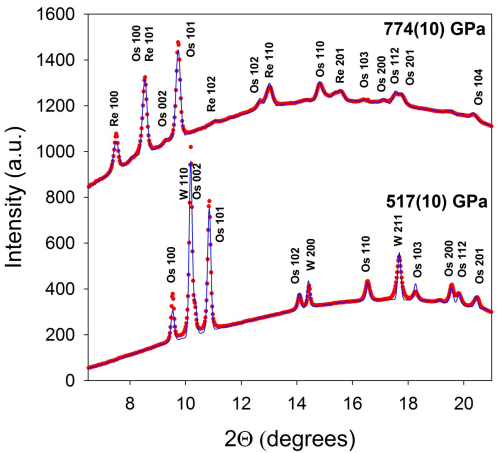
The most incompressible metal osmium at static pressures above 750 gigapascals
L. Dubrovinsky, N. Dubrovinskaia, E. Bykova, M. Bykov, V. Prakapenka, C. Prescher, K. Glazyrin, H.-P. Liermann, M. Hanfland, M. Ekholm, Q. Feng, L. V. Pourovskii, M. I. Katsnelson, J. M.Wills & I. A. Abrikosov
Nature 525, 226–229 (2015), doi:10.1038/nature14681
Metallic osmium (Os) is one of the most exceptional elemental materials. At ambient pressure it has the highest known density and one of the highest cohesive energies and melting temperatures. It is almost as incompressible as diamond. As any other material subjected to very high compression, osmium is expected to change its crystal structure. However, experiments at ultra-high pressures up to 770 GPa showed that it is not the case.
The international team of scientists using a devise for generation of ultra-high static pressures developed in Bayreuth University (Germany) and high-brilliance X-rays from synchrotron sources at APS (USA), ESRF (France), and PETRA III (Germany) demonstrated that even at pressures twice higher than in the center of the Earth osmium does not go through structural transformation. Instead, the team has found that at the pressure of about 440 GPa the metal undergoes electronic transitions which may be associated with pressure-induced interactions between core electrons. This fundamental result has important implications for understanding physics and chemistry of highly compressed matter, for design of materials to be used at extreme conditions, and for modelling interiors of giant planets and stars.

The synchrotron X-ray diffraction pattern of Os at pressure of 770 GPa gives evidence that osmium has unprecedented structural stability and at such huge pressures preserves the same crystal structure as at ambient conditions. However, anomalies in the behavior of the ratio of the lattice parameters detected upon compression revealed a signature of the core-level-crossing electronic transition, as suggested by the state-of-the-art theoretical calculations.
Tel: +49-(0) 921 55 3700 / 3766, Fax: +49-(0) 921 55 3769, E-mail: bayerisches.geoinstitut(at)uni-bayreuth.de